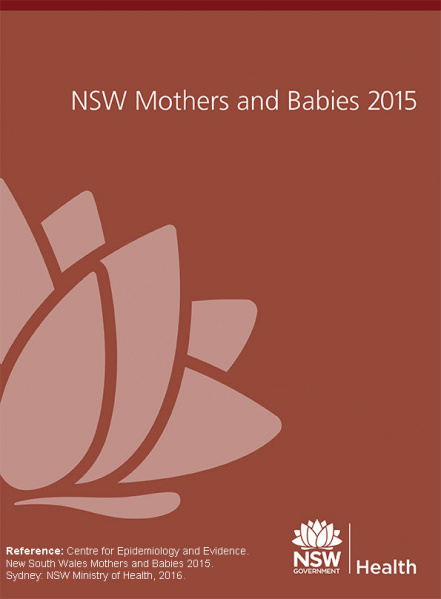File:New South Wales Mothers and Babies 2015.jpg

Original file (595 × 808 pixels, file size: 47 KB, MIME type: image/jpeg)
New South Wales Mothers and Babies (2015)
Cover of the report.
Centre for Epidemiology and Evidence. New South Wales Mothers and Babies 2015. Sydney: NSW Ministry of Health, 2016.
NSW is one of the largest states in Australia by population. The New South Wales Perinatal Data Collection (PDC) is a population-based surveillance system covering all births in NSW public and private hospitals, as well as home births. It encompasses all live births, and stillbirths of at least 20 weeks gestation or at least 400 grams birth weight.[1]
Brief Summary
- Number of births decreased from 97,245 in 2011 to 96,391 in 2015 (decrease of 0.9%).
- Percentage of teenage mothers fell from 3.2% in 2011 to 2.5% in 2015.
- Rate of normal vaginal birth decreased from 56.9% in 2011 to 56.0% in 2015.
- Operative and instrumental births were more common among privately than publicly insured mothers.
- Proportion of smoking mothers during pregnancy declined from 11.1% in 2011 to 8.9% in 2015.
- Majority of mothers planned to give birth in a hospital labour ward
- 87% per cent of mothers who planned to give birth in a birth centre actually did so.
- There were 187 homebirths in NSW reported in 2015.
- Premature babies (less than 37 weeks gestation) 7.9% (slight increase from 7.5% in 2011).
- Since 2011, the rate of low birth weight (less than 2,500 grams) has remained stable, ranging from 6.1% to 6.6%.
- Low birth weight rate was 6.6% in 2015.
- Between 2011 and 2015, the reported number of Aboriginal or Torres Strait Islander mothers giving birth increased from 2,975 to 3,823, an increase from 3.1% to 4.0% of all mothers.
- Aboriginal or Torres Strait Islander
- teenage mothers fell from 19.0% in 2011 to 15.4% in 2015.
- 45.0% of Aboriginal or Torres Strait Islander mothers reported smoking during pregnancy.
- Since 2011, rates of low birth weight and prematurity in Aboriginal or Torres Strait Islander babies has been over 11%. In 2015, 11.3% of Aboriginal or Torres Strait Islander babies were low birth weight and 12.7% were premature.
- Perinatal mortality rate of 9.6 per 1,000 births in Aboriginal or Torres Strait Islander mothers in 2015 is higher than the rate of 8.1 per 1,000 births experienced among babies born to non-Aboriginal or Torres Strait Islander mothers.
- Links: Birth | Australian Statistics
Reference
- ↑ Centre for Epidemiology and Evidence. New South Wales Mothers and Babies 2015. Sydney: NSW Ministry of Health, 2016.
Copyright
© NSW Ministry of Health 2016 This work is copyright. It may be reproduced in whole or in part for study or training purposes subject to the inclusion of an acknowledgement of the source. It may not be reproduced for commercial usage or sale. Reproduction for purposes other than those indicated above requires written permission from the NSW Ministry of Health. SHPN (CEE) 160466 ISBN 978-1-76000-530-6
Cite this page: Hill, M.A. (2024, April 27) Embryology New South Wales Mothers and Babies 2015.jpg. Retrieved from https://embryology.med.unsw.edu.au/embryology/index.php/File:New_South_Wales_Mothers_and_Babies_2015.jpg
- © Dr Mark Hill 2024, UNSW Embryology ISBN: 978 0 7334 2609 4 - UNSW CRICOS Provider Code No. 00098G
File history
Click on a date/time to view the file as it appeared at that time.
| Date/Time | Thumbnail | Dimensions | User | Comment | |
|---|---|---|---|---|---|
| current | 16:21, 25 January 2017 |  | 595 × 808 (47 KB) | Z8600021 (talk | contribs) | ==New South Wales Mothers and Babies (2015)== Cover of the report. Centre for Epidemiology and Evidence. New South Wales Mothers and Babies 2015. Sydney: NSW Ministry of Health, 2016. :'''Links:''' Birth | Australian Statistics ===Reference==... |
You cannot overwrite this file.
File usage
The following 2 pages use this file: